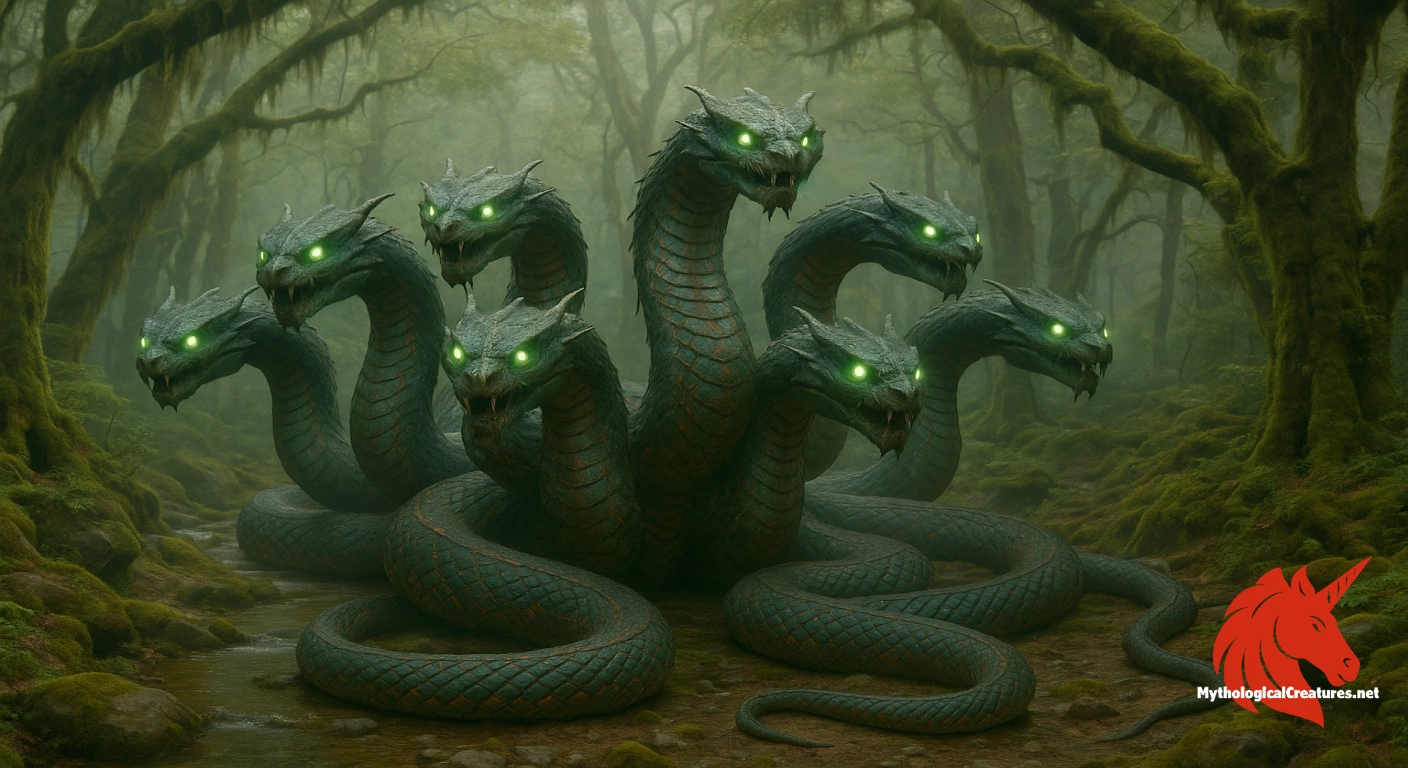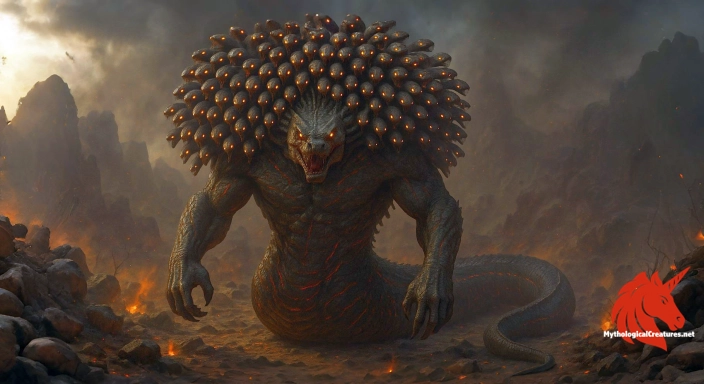Yamata no Orochi: Yamata no Orochi is a legendary Japanese serpent with eight heads and eight tails, known for its colossal size and ferocious nature.

Yamata no Orochi
Yamata no Orochi - Represents chaotic natural forces and the struggle between divine order and primordial chaos, particularly highlighted by its defeat at the hands of Susanoo.
Origins & First Encounters
Yamata no Orochi emerges from the mists of ancient myth as a colossal, eight-headed and eight-tailed serpent whose legend has permeated Japanese culture for millennia. It is a creature born out of the early narratives that blend the realms of the divine and the chaotic forces of nature. The myth is deeply interwoven with the earliest attempts by society to understand and order the turbulent phenomena surrounding them. Bearing an unmistakable array of eight heads and eight tails, this formidable being encapsulates the extremities of both creation and destruction. The creature is often associated with the heroic exploits of the storm god, creating a vibrant tapestry of conflict between cosmic order and rampant chaos. Its origins, recorded in ancient chronicles, have set the stage for countless adaptations and reinterpretations in art and literature. The narrative of Orochi not only symbolises the perennial struggle between order and disorder but also mirrors the human quest for balance within the natural world. As a potent emblem in mythology, its story has evolved through oral traditions and scholarly texts alike, infusing a sense of spectacle in every retelling. The beast’s mythic presence has, over time, inspired local rituals and creative expressions that underscore its timeless impact. Even today, the legend of Yamata no Orochi captivates audiences as a striking reminder of the dramatic interplay between the forces of nature and the divine.
Source Texts & Tale Variants
The earliest records of Yamata no Orochi can be traced to venerable texts that form the backbone of Japanese myth, such as the ancient chronicles which blend historical narrative with supernatural elements. These texts present a complex mosaic of the beast’s origins, detailing not only its physical terror but also its symbolic resonance within the pantheon of deities. Variants of the myth have evolved through centuries, with each retelling imbuing the story with distinct local colours and subtle narrative shifts. Storytellers have magnified the creature’s ominous attributes while integrating elements that resonate with the cyclical nature of the seasons and the rhythms of agrarian society. Multiple narrative strands reveal diverging interpretations regarding its role, sometimes depicting it as a personification of overwhelming natural calamity and at other times as a catalyst for divine intervention. Folk traditions have enriched the written records by inserting allegories and symbolic episodes that extend the reach of the myth. Chroniclers in later epochs refined these early accounts, crafting a narrative that interlaces heroism, chaos, and the transformative power of myth. There exists an ongoing dialogue between the ancient texts and contemporary retellings, each layered with nuances that reflect their respective historical contexts. The expansive nature of these sources highlights the creature’s multifaceted identity both as a terror of nature and as an enduring cultural icon. Its story endures through a constellation of historical narratives that continue to evoke wonder and introspection.
Form & Powers
Yamata no Orochi is visually arresting, marked by an imposing eight-headed visage coupled with eight sinuous tails that undulate with eerie grace. The creature’s immense body, depicted as a vast and sinuous serpent, is encrusted with rugged scales that shimmer with dark, muted hues. Each head is rendered with a fierce intensity, their eyes burning with a predatory glint and fangs that hint at a relentless, untamed aggression. The detailed imagery of its coiled form often portrays it as spanning great distances, a physical manifestation of chaos unfettered by natural law. The numerous tails, robust and powerful, contribute to a sense of controlled pandemonium, each one symbolising an aspect of destructive natural force. Variations in artistic depictions reveal slight differences in the curvature, length, and texture of its scales, all of which amplify the menace of the creature. The intricate portrayal of its anatomy serves not only as a testament to its fearsome strength but also as a symbolic narrative of complexity and multiplicity. The physicality of Yamata no Orochi is a blend of terrifying grandeur and mythical beauty, designed to evoke deep emotional responses from those who behold it. Its form, both awe-inspiring and formidable, challenges the boundaries between the monstrous and the divine. Every element of its appearance has been crafted to reflect a dual nature that oscillates between destruction and the creative drive inherent in the natural world.
Regional Faces
Regional renditions of Yamata no Orochi showcase a rich spectrum of local narrative flavours that mirror the diverse cultural landscapes of Japan. In many parts of the archipelago, the creature is not only a symbol of destruction but also a figure interwoven with the agricultural and seasonal cycles of life. Specific areas, such as the Izumo region, have developed distinctive depictions that incorporate elements of local rituals and communal celebrations. In these interpretations, the serpent’s colossal form is sometimes adorned with artistic embellishments that reflect indigenous aesthetics and spiritual symbolism. Local storytellers have reimagined aspects of the myth, introducing subtle modifications in its description, colour palette, and even the number of embellishments on its body. These adaptations often serve to align the myth with regional rites that celebrate renewal and the cyclical nature of existence. As the legend traversed through various locales, it absorbed contextual nuances that resonated with the environmental and cultural sensibilities specific to each community. The vibrant local portrayals have transformed Orochi from a mere embodiment of terror into a multifaceted symbol of both peril and promise. This dynamic regional layering enriches the myth while honouring the inherent diversity found within Japanese folklore. Thus, the creature’s narrative continues to be a living part of regional culture, evolving with the communities that cherish its mystique.
Cultural Parallels
The multi-headed Yamata no Orochi finds interesting parallels with other legendary beasts across global mythologies, weaving common threads with similar creatures in diverse cultures. Its configuration of several heads draws evident comparison to the Greek hydra, renowned for its regenerative and multi-faceted menace. The conceptual overlap extends further to some Eastern traditions where dragons embody both auspicious and fearsome characteristics, underscoring a universal tension between order and chaos. Such comparative analysis illuminates how different societies use the motif of multiplicity in head or tail to symbolise overwhelming natural forces. While myths like those of the hydra focus on the challenge of subduing a creature’s many aspects, the Japanese narrative leans towards the restoration of cosmic balance through its defeat. The alignment with other serpentine behemoths across cultures serves to highlight a shared mythic structure where heroic confrontation transforms chaos into order. Even as the narrative details differ, the underlying idea of a monstrous, multi-faceted adversary remains a potent symbol around the world. Cross-cultural reinterpretations have enriched the understanding of such creatures, placing Yamata no Orochi within a broader dialogue on the nature of divinity and the human condition. The comparative examination not only bridges Eastern and Western mythologies but also offers a window into the universal psyche grappling with the mysteries of creation and destruction. Ultimately, this cross-cultural resonance reinforces the timeless allure and complexity of the myth, inviting audiences to ponder its deeper connections.
Legacy & Modern Evolution
The legacy of Yamata no Orochi has evolved from its early depiction in sacred texts to a prominent presence in modern popular culture and art. Its narrative, once confined to ancient scrolls and oral traditions, now spans a broad array of media including literature, film, and digital artistry. The monstrous figure has transitioned from being merely a symbol of uncontrollable natural chaos to an icon that invites deeper reflection on themes of resilience and transformation. Over the centuries, artists have reimagined Orochi in countless forms, each iteration reflecting the social and cultural currents of its time. Modern interpretations often juxtapose its traditional fearsome image with contemporary aesthetics, thereby enriching the myth’s symbolic tapestry. The creature’s enduring influence is evident in its recurring appearance in festivals, architectural motifs, and even in the design of video game antagonists. As Yamata no Orochi continues to inspire a new generation of storytellers, it serves as a bridge between antiquity and the modern world, combining historical gravitas with innovative artistic expression. The transformation of its image over time speaks to the fluidity of myth and the perpetual reinvention of cultural symbols. Museums and cultural institutions now celebrate its story as a crucial element of Japan’s mythological heritage. Today, the legend remains a dynamic force, continually reinterpreted to resonate with contemporary audiences while preserving its ancient roots.
Interesting Fact
An interesting aspect of Yamata no Orochi is that its defeat by Susanoo led to the discovery of the sacred Kusanagi-no-Tsurugi, one of Japan's legendary imperial regalia.
Quick Creature Info
Associations:
Our Mythic Legendary Rating:

Also Sometimes Known As:
Habitat:
Supernatural Powers:
Physical Attributes:
Abilities:
Behavior:
Lore:
Related Creatures, Tales or Lore
- LLernaean Hydra
- JJormungandr
- NNāga (Hindu/Buddhist mythology)
References
Discover Another Mythical Legend You May Not Have Heard Of?
Uncover the mysteries of ancient folklore and expand your knowledge of legendary beings from cultures around the world.
Dare to Meet the Typhon....
Curated by the Mythological Creatures Team (rev. May 2025)
